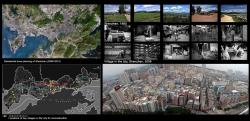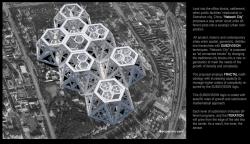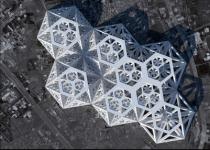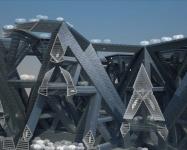Look into the office blocks, settlement, other public facilities’ relationship in Shenzhen city, China. “Network City” proposes a way which could unite different parts into a synergic urban composition. All ancient, historic and contemporary cities order spatial, geometric, distributive hierarchies with SUBDIVISION techniques. “Network City” is proposed as “all connected blocks” by changing the traditional city blocks into a new organization to meet the needs of the growth of density and complexity. The proposal employs FRACTAL methodology with increasing capacity to manage higher orders of complexity required by the SUBDIVISION logic. This SUBDIVISION logic is coded with specific rules of growth and subdivision mathematical approach. Each level of subdivision indicates different programs, and the ITERATION will grow from the edge of the site into the center. As a result, the inner, the denser.
Solved problem:
The “Network City” is a mix city, which contains settlement and office, as well as other public facilities. In this way of organization, it can solve 2 major city problems.
1. more greenery area
The problem of the villages in the city is extremely urgent now. In 1980, most of the area in Shenzhen was covered by trees and plants. The rapid economic growth turns Shenzhen into a young and prosperous city. But at the same time, it is also destroying the environment.
Most area is now covered by blocks of buildings with no trees, dirty environment. Most of the buildings are around 6-floors high. The distance of every adjacent blocks even less than 0.5m. People can shake hands from their opposite blocks. And that makes the place more dangerous to live in. In this case, thieves and gangsters cause many society problems. Because of the environmental problems as well as crime problems, the Shenzhen government planned to turn down those villages in the city to make a better city blocks with higher density.
Rapidly growing population also affects the organization of building blocks. Many public areas which supposed to be gardens and plazas are continuously occupied by Real Estate Company. They fill up the sea; they cut down the trees, just to satisfy the needs of the unexpected rapid growth of density.
We purpose a city that grows vertically instead of horizontally while the density goes up. In this way, the footprint area always remains the same, and the rest of the area will be greenery area. Inside the connected building block, there will be roof gardens, parks, plazas, to supply many communal spaces which can enhance the relationship of the people.
2. reduce air pollution
This proposal also tries to mitigate the pollution induced by transportation. An analysis report said that 70% of the air pollution is tail gas pollution. The main pollutants of the tail gas are CO, HC, NO, etc. In 2004, the tail gas pollution replaced the industrial waste gas pollution, and became the main pollutant source. If we can solve the tail gas problem, it may help the environment of Shenzhen a lot. In our proposal, we change the traditional organization of the building blocks.
“Network city proposed a united building block to shorten the distance of the business district and residential area. People don’t need to travel a long way between home and office everyday. Vertical circulation is the main transport way, so that in most cases, people use lifts and escalators instead of cars which generate exhaust gas to pollute the environment.
Design logic:
Fractal logic is our design method which inspired form the nature world. Network City proposes a new approach to connecting, form, space and materiality at various scales.
The Presence of fractal geometries occurs throughout nature. A general discription of a fractal could be a geometrical object that visually has the following two properties: It is infinitely detailed and self-similar. Fractals can be seen throughout nature, in plants, in clouds, in mountains just to name a few.
Natural objects that approximate fractals to a degree include clouds, mountain ranges, lightning bolts, coastlines, and snow flakes.
A fractal is generally a rough or fragmented geometric shape that can be split into parts, each of which is (at least approximately) a reduced-size copy of the whole, a property called self-similarity. A mathematical fractal is based on an equation that undergoes iteration, a form of feedback based on recursion.
2009
deCode : Jinqi Huang + Junkai Jian
.jpg)
.jpg)






